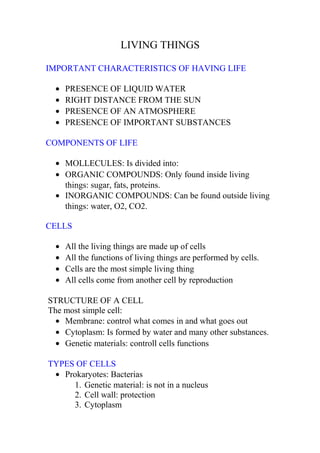Living things summary
•Télécharger en tant que DOC, PDF•
0 j'aime•732 vues
Signaler
Partager
Signaler
Partager

Recommandé
Contenu connexe
Tendances
Tendances (20)
Prokaryotes vs. Eukaryotes topic for Senior High School (General Biology 1)

Prokaryotes vs. Eukaryotes topic for Senior High School (General Biology 1)
4.2 4.3 biological structure and advantages of multicellular organisms UEC Se...

4.2 4.3 biological structure and advantages of multicellular organisms UEC Se...
Biology m3 movement of matls thru the cell membrane

Biology m3 movement of matls thru the cell membrane
En vedette
En vedette (9)
Understanding Gridshell Structures - Mannheim Multihalle Case Study

Understanding Gridshell Structures - Mannheim Multihalle Case Study
Similaire à Living things summary
Similaire à Living things summary (20)
Biology lecture 1 and 2_e6c1908877387bfcb9829159160b7c89.pptx

Biology lecture 1 and 2_e6c1908877387bfcb9829159160b7c89.pptx
the evolution health promotion and promotion program

the evolution health promotion and promotion program
Introduction to Environmental Microbiology (by- Meenu Malik)

Introduction to Environmental Microbiology (by- Meenu Malik)
Plus de davmartse
Plus de davmartse (20)
Dernier
Dernier (20)
Apidays New York 2024 - The value of a flexible API Management solution for O...

Apidays New York 2024 - The value of a flexible API Management solution for O...
Apidays Singapore 2024 - Building Digital Trust in a Digital Economy by Veron...

Apidays Singapore 2024 - Building Digital Trust in a Digital Economy by Veron...
How to Troubleshoot Apps for the Modern Connected Worker

How to Troubleshoot Apps for the Modern Connected Worker
Handwritten Text Recognition for manuscripts and early printed texts

Handwritten Text Recognition for manuscripts and early printed texts
Automating Google Workspace (GWS) & more with Apps Script

Automating Google Workspace (GWS) & more with Apps Script
Tech Trends Report 2024 Future Today Institute.pdf

Tech Trends Report 2024 Future Today Institute.pdf
Strategies for Unlocking Knowledge Management in Microsoft 365 in the Copilot...

Strategies for Unlocking Knowledge Management in Microsoft 365 in the Copilot...
[2024]Digital Global Overview Report 2024 Meltwater.pdf![[2024]Digital Global Overview Report 2024 Meltwater.pdf](data:image/gif;base64,R0lGODlhAQABAIAAAAAAAP///yH5BAEAAAAALAAAAAABAAEAAAIBRAA7)
![[2024]Digital Global Overview Report 2024 Meltwater.pdf](data:image/gif;base64,R0lGODlhAQABAIAAAAAAAP///yH5BAEAAAAALAAAAAABAAEAAAIBRAA7)
[2024]Digital Global Overview Report 2024 Meltwater.pdf
The 7 Things I Know About Cyber Security After 25 Years | April 2024

The 7 Things I Know About Cyber Security After 25 Years | April 2024
From Event to Action: Accelerate Your Decision Making with Real-Time Automation

From Event to Action: Accelerate Your Decision Making with Real-Time Automation
Bajaj Allianz Life Insurance Company - Insurer Innovation Award 2024

Bajaj Allianz Life Insurance Company - Insurer Innovation Award 2024
Axa Assurance Maroc - Insurer Innovation Award 2024

Axa Assurance Maroc - Insurer Innovation Award 2024
ProductAnonymous-April2024-WinProductDiscovery-MelissaKlemke

ProductAnonymous-April2024-WinProductDiscovery-MelissaKlemke
Living things summary
- 1. LIVING THINGS IMPORTANT CHARACTERISTICS OF HAVING LIFE • • • • PRESENCE OF LIQUID WATER RIGHT DISTANCE FROM THE SUN PRESENCE OF AN ATMOSPHERE PRESENCE OF IMPORTANT SUBSTANCES COMPONENTS OF LIFE • MOLLECULES: Is divided into: • ORGANIC COMPOUNDS: Only found inside living things: sugar, fats, proteins. • INORGANIC COMPOUNDS: Can be found outside living things: water, O2, CO2. CELLS • • • • All the living things are made up of cells All the functions of living things are performed by cells. Cells are the most simple living thing All cells come from another cell by reproduction STRUCTURE OF A CELL The most simple cell: • Membrane: control what comes in and what goes out • Cytoplasm: Is formed by water and many other substances. • Genetic materials: controll cells functions TYPES OF CELLS • Prokaryotes: Bacterias 1. Genetic material: is not in a nucleus 2. Cell wall: protection 3. Cytoplasm
- 2. 4. Membrane • Eukaryotic: plants and animal cells ANIMAL CELLS - Nucleus with genetic material - Membrane - Cytoplasm - Organelles PLANT CELLS - Nucleus -Membrane - Cytoplasm - Organelles (Chloroplast) FUNCTIONS OF LIVING THINGS • NUTRITION: a living thing needs to get nutrients from the environment to grow and to get energy. • REPRODUCTION: producing descdents that are equal or similiar to their parents. 1. Asexual: only partcipates one member. Descendents are equal to their parents. 2. Sexual: two individuals. Descendents are similar to their parents. • INTERACTION: being sensible to changes in the environment and giving responses. 1. Stimulli: Changes that could be sensed 2. Sense organs: Sense changes 3. Organs that produce responses: brain DIVERSITY IN LIVING THINGS All the species in the world share: • We are made of cells • We carry out the three vital functions • We have a common chemical composition - Bioelements: C, O, H - Biomolecules: inorganic organic
- 3. FOSSILS • Are The Remains of living things or their activities (tracks , eggs, excrement...) that have been preserved and now form part of sedementary rocks. • The Study of Fossils has allowed scientists to : 1. RECONSTRUCT AN IMPORTANT PART OF THE HISTORY OF LIFE Scientists have learned a lot about the characteristics of many extinct organisms and also about the changes of animals that also exist today. 2. OBTAIN INFORMATION OF THE HISTORY OF THE EARTH We can work exactly how long a particular organism first appeared on the planet . Also, fossilised remains offer very valuable information about environment in the past 3. MAKE A CALENDAR OF THE HISTORY OF THE EARTH The history of our planet is divided into eras and periods , which correspond to particular events, thanks to fossils, we can divide the different periods of time. We can also know about animals that appeared and disappeared. TAXONOMIC GROUPS Scientist use taxonomic groups to divide different groups of living things. Different taxonomic groups are: KINGDOMS => PHYLA => CLASSES => ORDERS => FAMILIES => GENERA => SPECIES
- 4. NAMING SPECIES Binomial naming Genus => Genus name Familiaris => Specific name Genus name => Homo Specific name => Sapiens FIVE KINGDOMS KINGDOM TYPE OF NUTRITION MONERAN Autotrophic or heterotrophic PROTIST AUTOTROPHIC OR HETEROTROPHIC FUNGUS HETEROTROPHIC PLANT ANIMAL CELLULAR ORGANISATION Single cell TYPE OF CELL prokaryotic HAS TISSUE? no SINGLE CELL OR EUKARYOTIC NO MULTICELLULAR SINGLE CELL OR EUKARYOTIC NO MULTICELLULAR AUTOTROPHIC MULTICELLULAR EUKARYOTIC YES HETEROTROPHIC MULTICELLULAR EUKARYOTIC YES